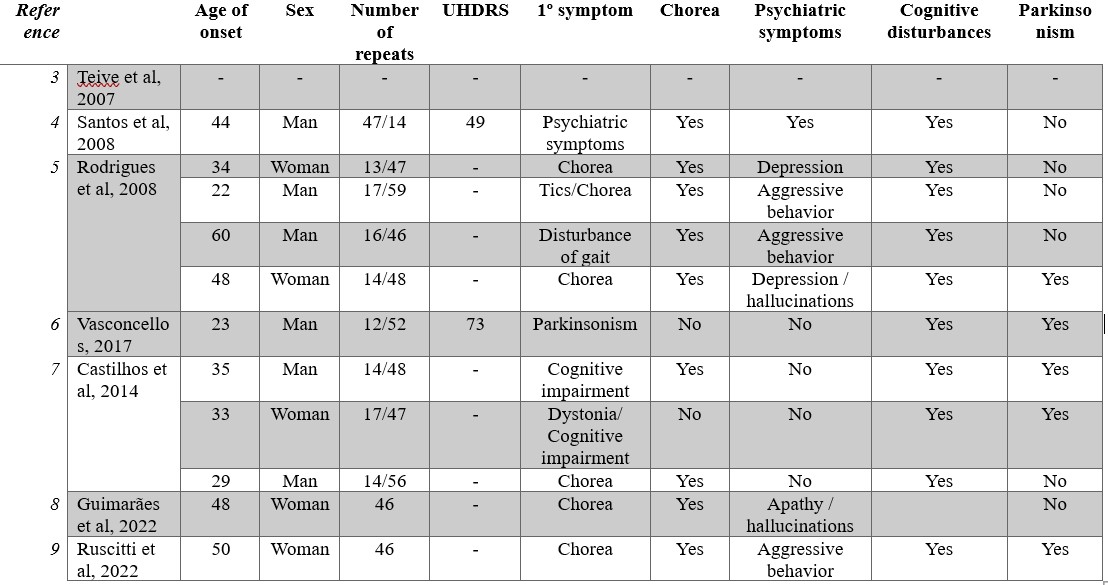Category: Choreas (Non-Huntington's Disease)
Objective: To describe the known phenotypic profile of HDL2 patients currently described in the literature.
Background: HDL2 is an autosomal dominant neurodegenerative disorder caused by a CTG/CAG expansion mutation in exon 2A of the juctophilin-3 (JPH3) gene on chromosome 16q24.3. It is the most common phenocopy of Huntington’s disease (HD). Studies of the neurocognitive profile of patients with HDL2 show that the syndrome is heterogeneous, with a variable rate of progression and severely impaired psychomotor and dexterity skills.1,2 Previous systematic reviews found that sixty-nine new cases were described between 2001 and 2016. African ancestry was present in all cases, and the majority were found in South Africa and the USA. Chorea was described in 84% of cases, dementia in 74%, parkinsonism in 37%, and psychiatric features in 93%.1
Method: Phenotype review of all Brazilian cases described in the literature since the JPH3 gene was described (2001) to the present.
Results: There are 30 articles describing a total of 91 individuals, most of them from South Africa.2,8,9 From Brazil, there are 7 articles describing 12 cases [table 1].3-9 One article was unavailable.3 Of the 11 cases described, 6 patients were male (54%). The age of onset ranged from 22 to 60 years (mean of 38.7 years and a median of 35 years). The number of CAG/CTG repeats ranged from 46 to 56, with a mean and median of 49 and 47, respectively. The Unified Huntington’s Disease Rating Scale (UHDRS) was described in only 2 studies.4,6 Chorea was present in 9 patients (82%), psychiatric symptoms in 7 (64%), cognitive disturbances in 10 (91%), parkinsonism in 7 (64%), and dystonia in only 1 patient (9%). The most common initial presentation was chorea (6 cases – 54%).
Conclusion: Some of our findings conflicted with those described in the literature. The most common symptom in our review was cognitive impairment, in contrast to what has been described previously (chorea). Parkinsonism was almost twice as common in Brazilian patients. Chorea remains the most common initial presentation. The median number of CAG/CTG does not differ between groups. The median age of onset is 38.7 years, compared to 41 years in other countries and similar to HD patients (40 years).1 In Brazil and worldwide, men continue to be the most affected group. There are a small number of papers describing UHDRS. More prospective studies are needed to better describe the HDL2 phenotype.
Table 1
References: 1. Anderson DG, Walker RH, Connor M, Carr J, Margolis RL, Krause A. A Systematic Review of the Huntington Disease-Like 2 Phenotype. J Huntingtons Dis. 2017;6(1):37-46. doi: 10.3233/JHD-160232. PMID: 28339400.
2. Krause, A., Anderson, D.G., Ferreira-Correia, A. et al. Huntington disease-like 2: insight into neurodegeneration from an African disease. Nat Rev Neurol 20, 36–49 (2024). https://doi.org/10.1038/s41582-023-00906-y
3. Teive, H. A. G. et al. Huntington’s disease-like 2: the first case report in Latin America in a patient without African ethnic origin. Mov. Disord. 22, S27 (2007).
4. Santos, C. et al. Huntington disease-like 2: the first patient with apparent European ancestry. Clin. Genet. 73, 480–485 (2008).
5. Rodrigues, G. G. R. et al. Huntington’s disease-like 2 in Brazil–report of 4 patients. Mov. Disord. 23, 2244–2247 (2008).
6. Castilhos, R. M. et al. Huntington disease and Huntington disease-like in a case series from Brazil. Clin. Genet. 86, 373–377 (2014).
7. Vasconcellos, L. F. R. et al. Huntington’s Disease like 2 presenting with isolated Parkinsonism. J. Neurol. Sci. 373, 105–106 (2017).
8. Guimarães TG, Parmera JB, Barbosa ER, Haddad MS, Cury RG. Teaching Video NeuroImage: Peculiar Hobby Horse Gait in Huntington Disease-like 2. Neurology. 2022 Jun 14;98(24):1031-1032. doi:10.1212/WNL.0000000000200603. Epub 2022 Apr 6. PMID: 35387851.
9. Ruscitti F, Origone P, Rosti G, Trevisan L, Marchese R, Brugnolo A, Massa F, Castellini P, Mandich P. A case of Huntington disease-like 2 in a patient of African ancestry: the everlasting support of clinical examination in the molecular era. Clin Case Rep. 2022 Oct 6;10(10):e6308. doi: 10.1002/ccr3.6308. PMID: 36237940; PMCID: PMC9536496.
To cite this abstract in AMA style:
D. Boone, M. Costa, C. Silva, L. Barcelos, B. Veiga, R. Pinto, P. Aguiar, S. Azevedo, V. Borges, H. Ferraz. Phenotypic Aspects of Huntington’s Disease-Like 2 in Brazil and the World: Literature Review [abstract]. Mov Disord. 2024; 39 (suppl 1). https://www.mdsabstracts.org/abstract/phenotypic-aspects-of-huntingtons-disease-like-2-in-brazil-and-the-world-literature-review/. Accessed December 19, 2025.« Back to 2024 International Congress
MDS Abstracts - https://www.mdsabstracts.org/abstract/phenotypic-aspects-of-huntingtons-disease-like-2-in-brazil-and-the-world-literature-review/

